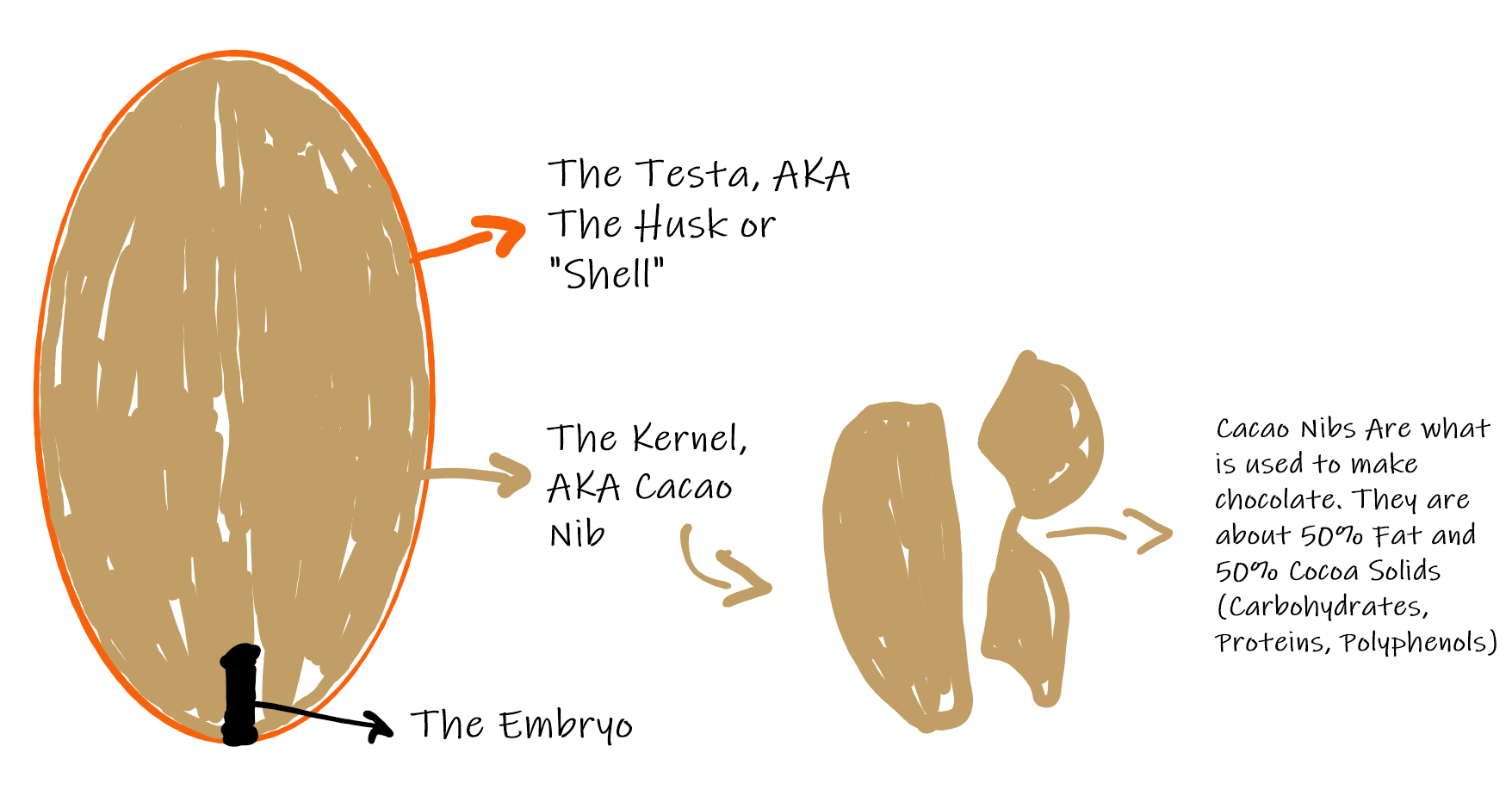Can You Make Chocolate Without Cocoa Beans?
The short answer is, no.
Sketch by Geoseph of the main components of a Cocoa Bean. It is the inside, the kernel, that we use to make chocolate.
Real chocolate is simple
Real chocolate has to be made with the kernel of the cacao bean which comes from the Theobroma cacao tree. The simplest chocolate in regards to ingredients is dark chocolate, which is essentially ground up cocoa nibs and sugar. That’s it.
Species related to cacao
There are some trees from the same Genus cacao is in, such as T. bicolor or Cupuacu which look similar to cacao. Making a chocolate-like product from the seeds of these is not possible either. The flavour, texture, and quality of the fat is nothing like that of T. cacao.
Carob
Some believe carob is related to chocolate, or a good substitute. This can’t be further from the truth. The carb is a legume. Due to it’s light brown colour, and peculiar flavour unlike many other seeds, people suggest it as a good substitute for chocolate.
This may be beneficial to those who are actually allergic to chocolate, but for the most part, there is no reason to substitute cacao. Some state unlike cocoa, carob has no caffeine. However, the caffeine in cocoa is very low. The caffeine content in a high percentage dark chocolate is equivalent to a couple cups of green tea, which we know has a very low caffeine content. And you would have to eat a whole bar of chocolate to equate that.
Types of chocolate
Based on ingredients, there are 3 categories of chocolate
Whole nib chocolate: AKA dark chocolate. This uses the whole nib, with the addition of sugar (unless it is 100% chocolate, for which it is just ground cocoa bean).
Flavoured whole nib chocolate. The same as above, but with a flavouring ingredient added during the processing. When the cocoa bean and sugar are grinding together, one can add ingredients such as:
Milk Powder: To create milk chocolate
Hazelnuts: To create gianduja
Tea Leaves: To create a earl grey tea chocolate
Almonds to create an chocolate almond bar
Fruit powders, salt, spices, etc.
These ingredients are not sprinkled in, but ground up and blended into the chocolate to create a uniform product. We assume milk chocolate is the “other type” of chocolate. But if you substitute the milk powder with ingredients mentioned above, you have a plethora of “types” of chocolate, all of which are essentially flavoured whole nib chocolate.
Cocoa butter based chocolate. This is chocolate made only from the fat of the cocoa bean. As mentioned in the image above, the kernel is 50% fat. The kernels can be pressed to release this fat we call cocoa butter. This cocoa butter can be mixed with sugar and another flavour ingredient to produce:
White chocolate (cocoa butter, sugar, milk powder)
Raspberry Bar (cocoa butter, sugar, raspberry powder)
Matcha Bar (cocoa butter, sugar, milk powder, matcha powder)
Almond Bar (cocoa butter, sugar, almonds)
Ruby chocolate (cocoa butter, sugar, milk powder, treated cocoa beans to make the chocolate pink and tart)
All these bars are based on the fat of the kernel, along with sugar and one or more flavour ingredient.
What makes chocolate unique is its fat!
What makes chocolate very unique is not just the taste (which is actually much more varied than most people think) but the fat of the cocoa bean. The fat we call cocoa butter is a mix of predominately 3 fatty acids (oleic, palmitic, stearic) whose properties give cocoa butter (and chocolate) the smooth, creamy melt that isn’t too waxy or oily. Something that is liquid at body temperature and melts beautifully in the mouth, but solid and room temperature and easy to package and transport (for the most part). It’s a very unique triglyceride.
Can’t I mix cocoa butter and cocoa powder to make chocolate?
That’s not really chocolate. Contrary to what most people believe, chocolate today isn’t made by mixing cocoa powder and cocoa butter and sugar. It is true that this is likely how the first chocolate bar was invented by Fry & Sons in 1847. Tinkering with a waste product (cocoa butter) and mixing sugar and cocoa powder (that was used for drinking chocolate).
However, soon after they realized chocolate could be consumed as a solid food, not just a drink, they made chocolate by grinding cocoa nibs (the kernel of the cocoa seed) into a fine paste often with sugar added in the case of dark chocolate. What gives chocolate it’s flavour is a mixture of many factors, the main ones being genetics, fermentation, roasting, and refining time. It’s the hours of grinding the beans that develops the unique flavour and texture of chocolate.
Mixing most cocoa powders and cocoa butters with sugar will likely produce a bland, off-tasting product.
There are many chocolate imitations that use cocoa powder and substitute cocoa butter with other fats such as palm kernel oil. They taste similar to chocolate, and contain part of what makes chocolate chocolate, but they are not chocolate!
There may be products on the market that are labelled or implied to be chocolate, but unless they are made with cocoa beans, no, it is not chocolate.
Chocolate is a Seed Butter
Chocolate is essentially a nut or seed butter. Cacao beans are not beans, but seeds from the cacao fruit. Just like we can grind pumpkin seeds to make pumpkin seed butter, or peanuts to make peanut butter, we can grind the seed of the cacao to make a thick paste.
This paste is unique from the others due to the unique capabilities of the fat of cacao, which is solid at room temperature, and melts at body temperature in the mouth. It can be molded and shaped unlike other nut butters, and the texture of cocoa butter (and chocolate) is not greasy, oily, and very satisfying!
